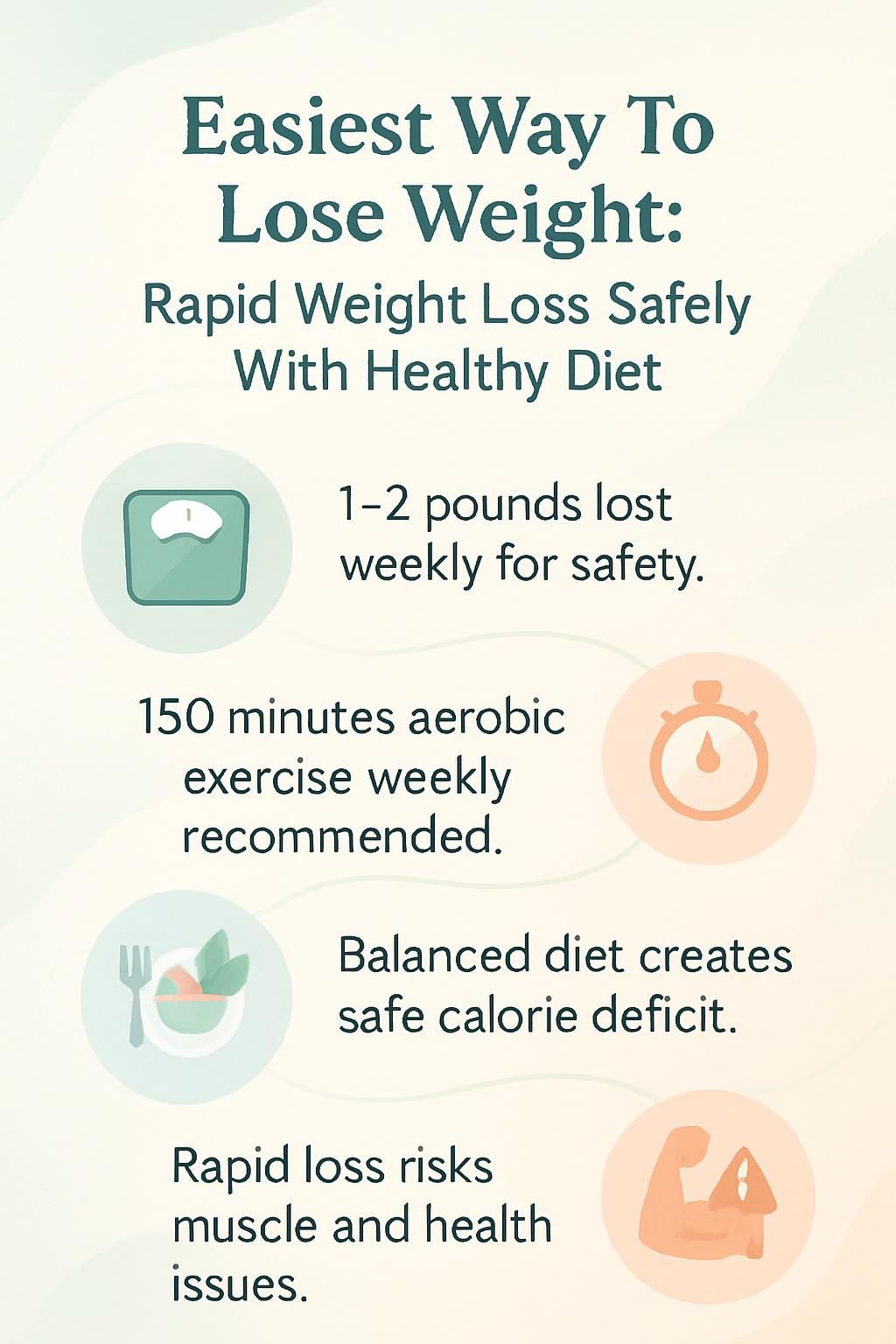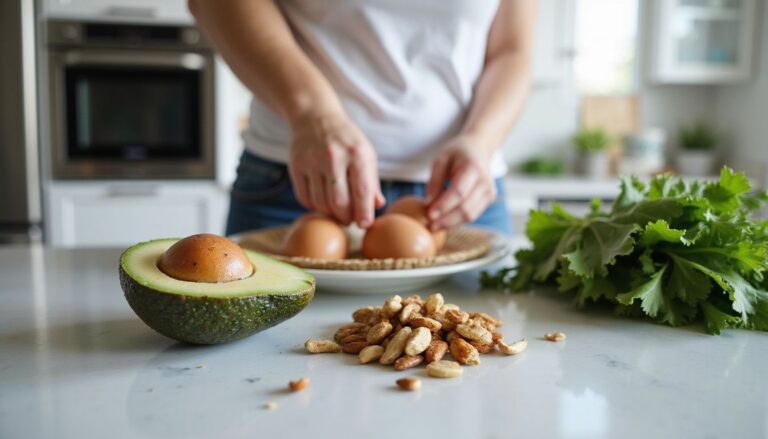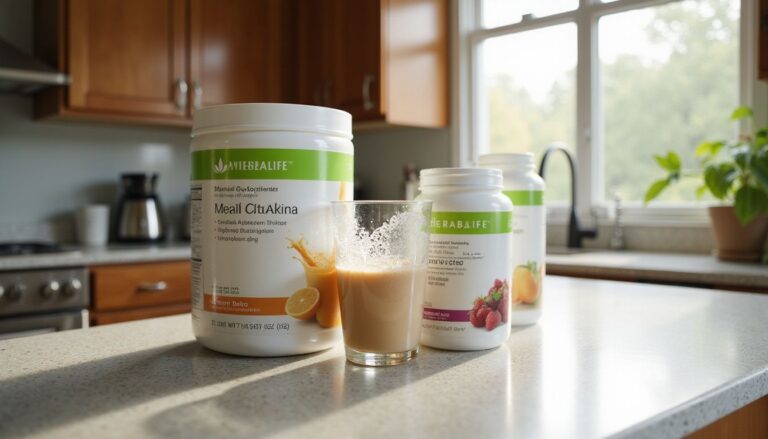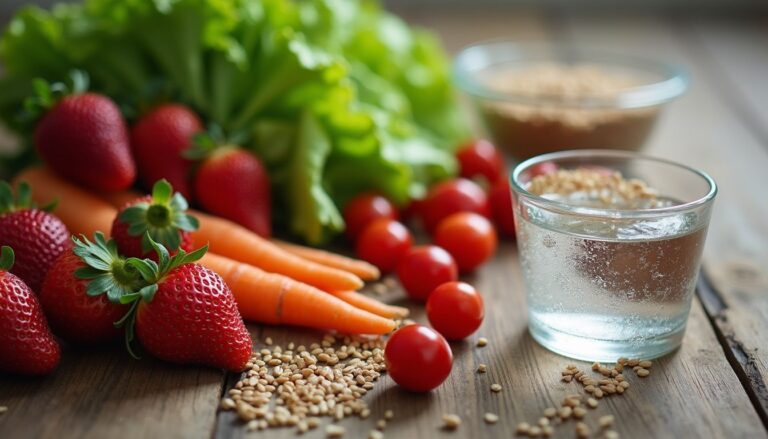Easiest Way To Lose Weight: Rapid Weight Loss Safely With Healthy Diet
Our Nutrition Assistant AI Suite will transform your body. You will lose fat, get toned, and build muscle. Gain confidence and optimal health.
If you have tried to lose weight and feel stuck, you are not alone. The Centers for Disease Control and Prevention reports that nearly half of U.S. adults try weight loss each year. The easiest way to lose weight is to create steady habits that combine a healthy diet and regular physical activity. This guide shares practical steps for rapid weight loss done safely, plus simple ways to avoid burnout.
You will learn how to build a calorie deficit, set realistic goals, and keep progress going. Small changes add up. Start today, and make each week a little better than the last.
Key Takeaways
- About half of U.S. adults attempt weight loss each year. A safe pace is 1 to 2 pounds per week, which supports long-term success (CDC).
- Creating a calorie deficit with balanced meals that include vegetables, fruits, whole grains, and lean protein is the core of safe fat loss.
- Losing more than 2 pounds per week increases the risk of muscle loss, gallstones, dehydration, and weight cycling, which may raise long-term health risks.
- Combining at least 150 minutes of weekly aerobic exercise with strength training preserves lean muscle and supports metabolism.
- Use a food journal or apps like MyFitnessPal to track progress. Skip fad diets and meal skipping to reduce rebound weight gain.

What is the importance of a calorie deficit for weight loss?

A calorie deficit means you eat fewer calories than your body uses each day. Your body then taps stored fat for energy. This is the basic path to weight loss, and it works at any age.
How is fat loss different from overall weight loss?
Fat loss is the reduction of body fat. Weight loss is any drop on the scale, including water and muscle. Very-low-calorie diets may show fast results, but much of that early loss can be water or lean tissue.
Protecting muscle matters. Muscle keeps metabolism steady and helps you feel strong. A few years ago I cut calories too hard and lost 20 pounds quickly, but my strength fell in the gym. A balanced plan with enough protein helped me recover and keep fat off without losing power.
Slow, steady changes that favor whole foods and reasonable portions support fat loss while preserving muscle.
Rapid Weight Loss vs. Sustainable Weight Loss
Quick drops on the scale can look exciting, but sustainability keeps the weight off. Think sprint versus steady jog.
What are the risks of losing weight too quickly?
Very fast weight loss often causes muscle loss, a slower metabolism, and higher fatigue. Cutting calories too much can trigger hair shedding, nutrient gaps, and weaker immunity. Dropping more than 2 pounds per week also raises the risk of gallstones and dehydration.
Rapid diets tend to lead to weight cycling, which is losing and regaining the same pounds. Repeated cycles are linked to higher risks for type 2 diabetes and heart issues over time. Extreme plans can also disrupt appetite hormones, which increases hunger and irritability.
Quick fixes rarely create lasting change. Daily habits do.
Choose healthy eating patterns, aim for at least 150 minutes of weekly activity, and build meals around vegetables, fruits, whole grains, and lean protein.
What are the benefits of safe and healthy weight loss?
A moderate pace, about 1 to 2 pounds per week, helps you keep the weight off. You also lower the risk for heart disease, type 2 diabetes, and high blood pressure by pairing a balanced diet with regular exercise.
Gradual fat loss protects muscle mass, reduces belly fat, and supports a steady metabolism. If you need help setting targets, find a doctor or a registered dietitian. Safe methods make long-term success more likely.
Key Components of a Healthy Diet for Weight Loss
Balanced meals help you feel full, manage hunger, and stay consistent. Aim for simple, repeatable steps that fit your life.
How to balance protein, carbs, and fats in your diet?
Protein, carbohydrates, and fats each play a role. Getting the mix right supports weight loss and healthy body composition.
- Aim for 25 to 30 percent of calories from protein to support muscle, satiety, and fat loss.
- Choose complex carbohydrates like oats, brown rice, quinoa, and whole-grain bread for steady energy and blood sugar control.
- Include healthy fats from olive oil, nuts, seeds, and avocados for heart health and meal satisfaction.
- Limit high-sugar foods such as soft drinks and sweets since they add calories without nutrition and can spike blood sugar.
- Use USDA MyPlate: half your plate vegetables and fruits, one quarter lean protein like fish or beans, one quarter whole grains. Keep added fats modest.
- Watch portions of bread, pasta, and rice to avoid overshooting your calorie target.
- Eat balanced meals and snacks at regular times to prevent crashes and late-night overeating.
Many people find that this balance reduces belly fat while meeting daily nutrient needs.
Why include vegetables, fruits, and whole grains?
Vegetables, fruits, and whole grains deliver fiber, vitamins, and minerals that support weight loss and health. They fill your plate without piling on calories.
- Vegetables are low in calories and high in fiber, which helps you feel full and meet your calorie goals.
- Fruits add natural sweetness plus vitamins and antioxidants that protect your cells and curb sugar cravings.
- Whole grains like oats, brown rice, and whole wheat release energy slowly and help stabilize blood sugar.
- Plant-forward eating supports heart health and may reduce disease risk, as noted by the American Heart Association.
- High-fiber foods such as beans and lentils support digestion, improve cholesterol, and extend fullness between meals.
- Choosing whole grains over refined grains often lowers sodium intake and can support healthy blood pressure.
- A nutrient-rich pattern that favors plants supports immune health and active living.
Next, see how trimming processed foods and added sugars speeds progress.
How to reduce processed foods and added sugars?
Cutting back on processed items helps you control calories and improve nutrition. Start with simple swaps you can keep up.
- Read labels. Look for added sugars such as dextrose, fructose, or corn syrup in cereals, sauces, and drinks.
- Pick whole foods like vegetables, fruits, nuts, and unprocessed lean proteins instead of packaged snacks.
- Limit sugary drinks including soda, energy drinks, and most bottled juices. Water is best for hydration.
- Cook more meals at home to control ingredients, portions, and added sugar.
- Swap desserts for fruit most days to satisfy a sweet tooth with fewer calories.
- Use herbs and spices rather than sugary sauces or dressings.
- Set weekly goals, such as replacing one processed item with a whole-food option.
- Shop the produce section first and limit aisles with ultra-processed products.
- Track intake with an app or diary to spot and replace high-sugar habits.
- Try plant-based meals a few times a week to reduce processed foods and unhealthy fats.
These steps support safe, rapid weight loss while keeping energy steady.
What are effective strategies for rapid weight loss?
Rapid weight loss can be done safely if you use proven methods. Pair eating strategies with active days for best results.
How does intermittent fasting help with weight loss?
Intermittent fasting limits the hours you eat, which often lowers daily calories. Many people lose about 0.5 to 1 kilogram per week with this approach, which fits recommended safe rates.
Hunger often fades as your body adjusts appetite hormones. A 2020 review found that intermittent fasting can reduce body mass index and belly fat compared with typical eating patterns. I used a simple 12 p.m. to 8 p.m. eating window, keeping meals balanced with vegetables, lean protein, whole grains, and fruit. Portions were easier to manage without feeling deprived.
Fasting works best when combined with a healthy diet that limits processed foods and added sugars. Speak with a healthcare professional if you take medications or have medical conditions.
What are low-carb and ketogenic diets?
Low-carb diets reduce total carbohydrate intake so your body uses stored fat for energy. The ketogenic diet goes lower, often 20 to 50 grams of carbs per day, which raises ketones, a fuel made from fat.
Research shows low-carb plans can reduce hunger and support faster early weight loss. I tried a moderate low-carb plan and noticed less bloating in the first week. If you choose this route, monitor carb intake, prioritize non-starchy vegetables, and keep protein steady. Add regular aerobic exercise for stronger results.
How can portion control and mindful eating aid weight loss?
Smaller portions reduce calories without banning favorite foods. People tend to eat more when served more, even without noticing. Using smaller plates or measuring servings keeps portions in check.
Mindful eating means slowing down and noting hunger and fullness cues. It takes about 20 minutes for fullness signals to reach your brain. I tracked meals for one week and realized many snacks were habit, not hunger. Mindful pauses helped me stop sooner and enjoy food more.
Portion control plus mindful eating makes it easier to stay in a calorie deficit and maintain consistency.
How does physical activity support weight loss?
Movement helps burn calories and protects your heart. It also supports mood and energy, which makes healthy eating easier to sustain.
What aerobic exercises burn the most calories?
Aerobic exercise raises your heart rate and boosts calorie burn. Aim for at least 150 minutes of moderate activity per week.
- Running at 6 mph burns about 660 calories per hour for a 155-pound person and works many muscle groups.
- Jump rope can burn up to 900 calories per hour with a steady rhythm. Intervals add an extra challenge.
- Swimming laps at a brisk pace burns about 590 calories per hour and is gentle on your joints.
- Outdoor cycling faster than 12 mph burns roughly 500 to 700 calories per hour. Hills increase the burn.
- Rowing machines work both upper and lower body, often 520 to 610 calories per hour.
- High-impact classes such as Zumba or kickboxing can burn 480 to 680 calories per session.
- Brisk walking at 4 mph burns about 340 to 440 calories per hour and fits easily into daily routines.
Choose activities you enjoy. The best workout is the one you will repeat.
Why is strength training important for muscle mass?
Strength training signals your body to keep and build muscle while you lose fat. Without it, you risk losing lean tissue along with weight. Lifting two or three times per week helps preserve muscle and metabolism.
I saw the biggest changes by pairing cardio minutes with two weekly strength sessions. You do not need heavy gear. Bodyweight moves like push-ups, squats, and planks work well.
How to add daily movement and active habits?
Small bursts of movement throughout the day increase your total energy burn. These micro-moves stack up.
- Walk or bike short trips. Aim for 30 minutes daily.
- Take the stairs when you can to raise your heart rate.
- Stand and stretch every hour during long sitting periods.
- Play active games with your child after meals.
- Set hourly reminders to move for a few minutes.
- Park farther away to get extra steps.
- Do household tasks like cleaning or gardening with purpose.
- Schedule a 10 to 20 minute walk after dinner.
- Use a step counter or phone app to track progress.
- Try new active hobbies like dancing, swimming, yoga, or martial arts.
- Invite friends or family to join. Social support boosts motivation.
These habits support steady progress and reduce the need for extreme measures.
What lifestyle habits help support weight loss?
Healthy daily routines amplify your results. Think of these as the glue that keeps your plan together.
How much water should you drink daily?
A common target is eight 8-ounce glasses per day, about 2 liters. The National Academies of Sciences suggests about 3.7 liters for men and 2.7 liters for women from all foods and drinks combined. Your needs rise with heat and exercise.
Thirst is a strong guide. Carry a bottle and sip through the day. Pale-yellow urine often signals good hydration.
Why is getting enough sleep crucial?
Sleep helps regulate hormones that control hunger and fullness, including ghrelin and leptin. Adults who sleep under 7 hours per night have higher rates of obesity than those who sleep 7 to 9 hours.
When tired, cravings rise and metabolism can slow. I notice snack urges climb after short nights. Protecting sleep makes appetite control and workouts feel easier.
How to manage stress effectively?
Short movement breaks, deep breathing, and a steady sleep schedule reduce stress. Regular exercise lowers anxiety and depression in many people.
I started a short journal routine to spot common triggers. A weekly yoga class helped me relax and stick to my plan. Hydration also supports mood, while dehydration can raise cortisol, the main stress hormone.
Lower stress helps you make better food choices and stay consistent.
What common weight loss mistakes should you avoid?
A few missteps can stall progress. Fixing them protects results and confidence.
Why is over-restricting calories harmful?
Severe calorie cuts can slow metabolism and increase muscle loss, especially under 1,200 calories for most women and 1,500 for most men. Low energy, hair shedding, and reduced immunity can follow. Hormone changes may affect menstrual cycles and testosterone.
One study published through the National Institutes of Health reported greater lean mass loss with very low calorie approaches compared with moderate reductions.^1 A steady calorie deficit with enough protein and strength training delivers better long-term results.
^1 Hall KD. “Energy Expenditure and Body Composition Changes after an Isocaloric Ketogenic Diet in Overweight and Obese Men.” American Journal of Clinical Nutrition. 2016;104(2):324-333.
What are the risks of skipping meals?
Skipping meals can cause low blood sugar, fatigue, and headaches. It also sets up overeating later in the day. Mood and focus may suffer, and long gaps can add stress to the body.
Regular meals with balanced protein, carbs, and fats keep energy steady. I once skipped lunch for several days in college and found workouts far harder. Predictable meal times worked much better.
Why should you avoid fad diets?
Fad diets often cut entire food groups and lack key nutrients. Many people regain the weight quickly after stopping them. Extreme plans can increase dehydration and muscle loss.
I tried a juice cleanse years ago and felt lightheaded and hungry. Evidence-based strategies centered on real foods are safer and easier to maintain.
How to track your weight loss progress effectively?
Tracking helps you see what works. It also makes small wins visible, which keeps motivation up.
Why monitor weight and body measurements?
The scale can shift from water changes or muscle gain. Measuring waist, hips, and other spots can show fat loss even when weight stalls. I measured my waist weekly and saw inches drop before the scale moved.
Tracking both weight and measurements helps you confirm fat loss and spot muscle preservation. A larger waist is linked to higher heart risk. Many adults aim for under 35 inches for most women and under 40 inches for most men.
What food and fitness tracking tools are useful?
Pick a tool that fits your routine. Simplicity improves consistency.
- MyFitnessPal logs meals and workouts, with calories and macronutrients.
- Fitbit app tracks steps, heart rate, calories burned, water, and sleep.
- Cronometer offers detailed vitamin and mineral tracking for nutrient balance.
- Lose It! scans barcodes and shows easy charts to spot patterns.
- Apple Health brings data together from multiple apps and devices.
- Google Fit tracks activity through your phone or connected devices.
- A paper food diary works if you prefer writing by hand.
Any method is fine if you use it daily. Consistency matters more than the tool.
How to set realistic and achievable goals?
Break big goals into smaller targets. Aim to lose 1 to 2 pounds per week, as the CDC suggests. Use SMART goals, which are specific, measurable, achievable, relevant, and time-bound.
For example, plan a 30-minute walk each day or swap soda for water on weekdays. Post your goals where you will see them. Short challenges, like adding a vegetable at lunch each day for a week, build momentum.
How to maintain weight loss long-term?
Maintenance relies on simple routines that feel natural. Think repeatable meals, regular activity, and steady sleep.
What are sustainable eating habits?
Build habits you can follow year-round. These steps help you keep weight off without feeling deprived.
- Eat a variety of vegetables, fruits, lean proteins, whole grains, and healthy fats most days.
- Control portions with smaller plates or measuring tools.
- Keep regular meal times to reduce grazing and overeating.
- Choose whole foods over ultra-processed options to limit added sugars and sodium.
- Cut sugary drinks. They add calories without fullness.
- Cook at home more often to manage ingredients and portions.
- Focus on steady progress rather than quick fixes.
Pair these habits with consistent movement for the best chance of long-term success.
Why continue regular physical activity?
Regular exercise helps preserve muscle and keeps your metabolism higher. It also lifts mood and energy. I started a 30-minute post-dinner walk and noticed fewer late-night snacks.
Adults who get at least 150 minutes of exercise each week are less likely to regain lost weight. Activity supports heart, bones, and blood pressure too.
How to celebrate progress without regaining weight?
Reward your effort in ways that do not derail your plan. New workout gear, a massage, or an active outing can feel great without adding extra calories.
Track non-scale wins like better energy or looser clothes. I celebrated a milestone by signing up for a 5K run instead of grabbing dessert. It kept my momentum going.
When should you seek professional guidance for weight loss?
Some situations call for extra support. Medical conditions, medications, or repeated plateaus are good reasons to get expert help.
Why consult a dietitian or nutritionist?
A registered dietitian can tailor a plan to your health needs, preferences, and goals. People who work with dietitians are more likely to lose weight and keep it off.
Dietitians teach portion control, label reading, and balanced meals based on real foods. Working with a nutrition expert helped me see how small changes compound over time.
What medical interventions are available for obesity?
If diet and exercise are not enough, doctors may recommend medications such as orlistat, phentermine-topiramate, or semaglutide. These can reduce appetite or limit fat absorption.
Bariatric surgery may be an option for a body mass index of 40 or higher, or 35 with serious health risks. Procedures include gastric bypass and sleeve gastrectomy. Doctors monitor progress and side effects, and healthy habits remain essential for success.
Conclusion
You can lose weight safely and keep it off. Focus on a healthy diet built around vegetables, fruits, whole grains, lean protein, and smart portions. Add regular physical activity and strength training to protect muscle. Track your progress and set realistic goals that fit your life.
Rapid weight loss is possible when done safely. If you have health conditions, are taking medications, or need extra support, talk with a healthcare professional or a registered dietitian. This article is educational and does not replace medical advice. With patience and consistent action, you can reach your weight loss goals and feel better day to day.
FAQs
1. What is the safest way to achieve rapid weight loss with a healthy diet?
The safest method involves eating fewer calories than you burn, choosing nutrient-rich foods like vegetables and lean protein, and avoiding processed snacks. Research from the Centers for Disease Control and Prevention shows that losing 1 to 2 pounds per week is safe for most adults.
2. Which foods support quick yet healthy weight loss?
Foods high in fiber such as beans, whole grains, fruits, and leafy greens help you feel full longer. Lean meats like chicken breast or fish provide protein without excess fat. A study published in The American Journal of Clinical Nutrition found that diets rich in these foods can lead to steady weight reduction.
3. How important is exercise when trying to lose weight fast but safely?
Physical activity helps burn extra calories while preserving muscle mass during calorie restriction. Walking briskly for at least 150 minutes each week supports both heart health and fat loss according to guidelines from the U.S. Department of Health & Human Services.
4. Can personal experience help guide my approach to rapid yet safe weight loss?
Yes; tracking your meals and progress can reveal patterns that affect results over time. For example, I noticed better outcomes when I planned meals ahead using a food diary app which helped me avoid unhealthy choices during busy days.
Summary: Safe rapid weight loss relies on balanced nutrition, regular movement, smart food choices based on evidence-based research, and self-monitoring habits for lasting change.







